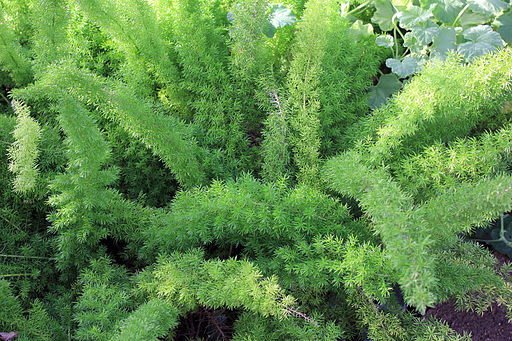Ferns to Know and Grow
Click here for printable sheet
Boston Fern
Latin Name: Nephrolepis exaltata bostoniensis
Boston ferns are among the easiest of all ferns to grow. They grow best in a north-facing window in a cool room.
Needs:
Bright to medium light
Plentiful water
High humidity
60° to 65° indoor temperature
Fertilize during growing season
Can summer out-of-doors
Other cultivars:
Compacta -- 18" fronds
Fluffy Ruffles -- double-edged 12“ fronds
Verona-- lacy with triple, filmy 12" fronds
Dallas -- a miniature
Rabbit's Foot Fern and Squirrel's Foot Fern
Latin Name:
Davallia fejeesis — Rabbit's Foot Fern
Davallia trichomanoides — Squirrel's Foot Fern
This fern puts out unusual rhizomes that crawl along the top of the soil and even outside the plant's container. Because the rhizomes have a furry texture, Davallia ls commonly called Rabbit's Foot or Squirrel's Foot Fern. It is best grown in hanging baskets.
Needs:
Medium light
Average temperature
Easy to grow
Asparagus Fern
Latin Name:
Asparagus densiflorus ‘Sprengeri’--Asparagus Fern
Asparagus densiflorus ‘Myen'-- Foxtail Fern
Asparagus steaceus liliaceae — Plumosa Fern
Asparagus ferns are not true ferns because they reproduce from seed, not spores. They really are related to the vegetable asparagus though!
Needs:
Bright indirect light
Abundant water during growing season
Less water in winter
Minimum winter temperature is 44°
Fertilize bi-monthly during growing season
Bird's Nest Fern and Mother Fern
The Asplenium group of ferns offers considerable diversity.
Asplenium bulbiferum - Commonly called Mother Fern or Hen and Chickens Fern. This has graceful, finely cut fronds, sometimes reaching four feet in length. Unlike most ferns, it produces plantlets along its fronds that can be removed and planted — hence the plant's common name.
Asplenium nidus-Commonly called Bird's Nest Fern. This variety produces showy fronds to four feet long and 8" wide, growing upright in a cluster, completely undivided or cut.
Needs:
Medium light
Average temperature
Easy to grow
Staghorn Fern
Latin Name: Platycerium bifurcatum
Staghorn or Elkhorn Fern is an epiphyte: it attaches to the side of a tree, sustaining itself on leaf mold and moisture that gathers around its roots. Gardeners grow Staghorn Fern on a slab of bark, on the stem of a tree fern, or occasionally in a hanging basket or on a tree.
Needs:
Bright, even direct light if not too intense
Keep on the dry side. Water only when plant's bark or moss feels dry.
60° to 70° temperature
2 to 3 times a year, sink roots into fertilizer solution
Brake Fern or Table Fern
Latin Name: Pteris cretica, Pteris cretica ’AIbolineata‘ --white bands, also called Ribbon Fern
The Pteris ferns are mostly small ferns of subtropical or tropical origin, best suited to dish gardens or small pots
Needs:
Bright, indirect light
Moist, but not soggy conditions
Average temperatures
Button Fern
Latin Name: Pellaea rotundifolia
In nature, Pellaeas, or cliff-brake ferns, mostly grow on rocks. Of the few species grown indoors, by far the most popular is P. rotundifolia, the Button Fern. Propagate by division.
Needs:
Medium light
Additional humidity— keep constantly moist.
Temperatures on the cool side
In soil-less mix, feed with half strength fertilizer every two weeks, spring to fall.
If potted in soil, feed once a month
Maidenhair Fern
Latin Name:
Adiantum capillus-veneris--Venus Maidenhair
Adiantum raddianum--Delta Maidenhair
The Adiantum, or Maidenhair Fern, is among the most delicate and beautiful of all ferns. Most are native to the tropics, although a few are native to the United States. Extremely thin and wiry, the stems are usually dark brown or black. Foliage is very thin textured and delicate; fronds are finely cut and most leaflets are fan shaped.
Needs:
Semi-shaded location
Never allow soil to dry out!
Needs extra humidity
Hare's Foot Fern and Knight's Fern
Latin Name:
Polypodium aureum--Hare's Foot
Polypodium aureum Mandanianum--Lettuce Fern
Polypodium subauriculatum 'Knightiae’—Knight’s Fern
The Polypodium ferns include Hare's Foot Fern, a large fern with flat fronds 3 to 5 feet long. Another version, sometimes called Lettuce Fern, has fronds with frilled and wavy edges. Knight's Fern, also with frilled edges, looks something like a glorified Boston fern. All make good hanging basket displays.
Needs:
Semi-shaded conditions
Very moist soil
Average temperatures
Rainbow and Peacock Ferns, (clubmosses and spikemosses)
Latin Name: Selaginella wiIdenovii--Peacock Fern
Selaginella uncinata-- Rainbow Fern
Selaginella kraussiana--Krause's clubmoss
The Selaginella "Ferns", sometime called spikemoss or clubmoss, are moss-like plants that reproduce from spores, not seeds.
Needs:
Warmth and high humidity
Really only suited to greenhouses or terrariums
Medium to low light
Keep soil constantly moist
Feed once or twice a year
There are also a number of ferns that are perennial in our area and are suitable for outdoor landscaping and container use. Holly fern, Christmas fern, and autumn fern are evergreen in our area, making them useful In the winter landscape or winter containers.
Boston fern By Mokkie (Own work) [CC BY-SA 3.0 (http://creativecommons.org/licenses/by-sa/3.0)], via Wikimedia Commons
Rabbit's foot fern by Forest & Kim Starr [CC BY 3.0 (http://creativecommons.org/licenses/by/3.0)], via Wikimedia Commons
Asparagus fern by Yinan Chen (www.goodfreephotos.com (gallery, image)) [Public Domain], via Wikimedia Commons
Mother fern By brewbooks [CC BY-SA 2.0 (http://creativecommons.org/licenses/by-sa/2.0)], via Wikimedia Commons
Bird's nest fern by Daderot (Own work) [Public domain], via Wikimedia Commons
Staghorn fern by Tequila CC-BY-SA-3.0 (http://creativecommons.org/licenses/by-sa/3.0/), via Wikimedia Commons
Brake fern by Jerzy Opioła (Own work) [CC BY-SA 4.0-3.0-2.5-2.0-1.0 (http://creativecommons.org/licenses/by-sa/4.0-3.0-2.5-2.0-1.0)], via Wikimedia Commons
Button fern by Stickpen (Own work) [Public domain], via Wikimedia Commons
Maidenhair fern by Tigerente (Own work) [CC BY-SA 3.0 (http://creativecommons.org/licenses/by-sa/3.0)], via Wikimedia Commons
Hare's foot fern by and (c)2006 Derek Ramsey (Ram-Man). Location credit to the Chanticleer Garden. (Own work) [CC-BY-SA-3.0 (http://creativecommons.org/licenses/by-sa/3.0/)], via Wikimedia Commons
Krause's clubmoss by Jerzy Opioła ({Own}) [CC BY-SA 4.0-3.0-2.5-2.0-1.0 (http://creativecommons.org/licenses/by-sa/4.0-3.0-2.5-2.0-1.0)], via Wikimedia Commons











